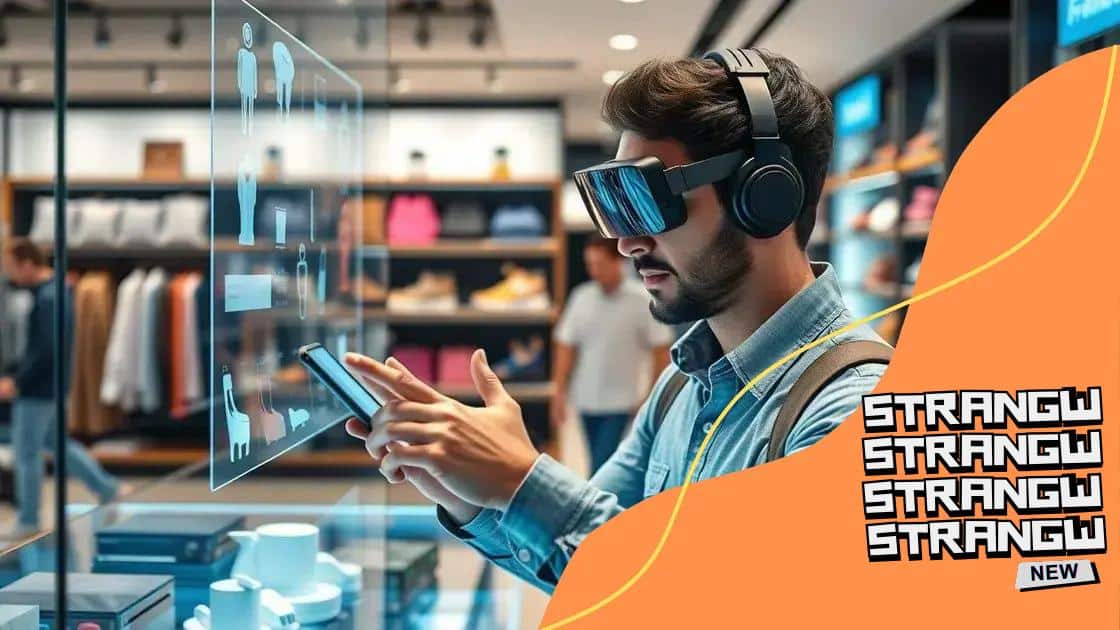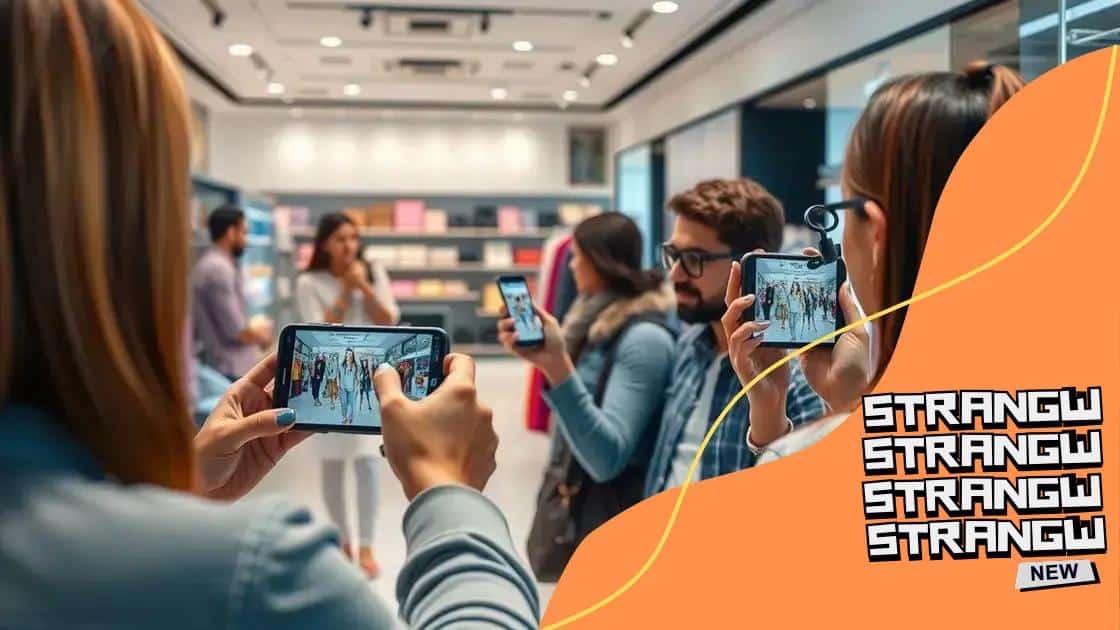Augmented reality applications in retail marketing

Augmented reality applications in retail marketing enhance customer engagement and boost sales by allowing consumers to interact with products virtually, creating personalized and immersive shopping experiences.
Augmented reality applications in retail marketing are changing how we shop today. Imagine trying on clothes virtually or seeing how furniture looks in your living room before buying. These innovations create engaging experiences for customers, making them eager to learn more.
Understanding augmented reality in retail
Understanding augmented reality in retail can greatly enhance the shopping experience for consumers. This innovative technology merges digital content with the real world, allowing customers to interact with products in exciting new ways.
The Basics of Augmented Reality
Augmented reality (AR) is a technology that overlays digital information onto the real world. It uses devices like smartphones, tablets, and AR glasses to present users with a view of their physical environment blended with virtual elements.
How AR Works in Retail
In retail settings, AR applications can provide customers with a unique experience as they shop. Customers can visualize products in their own space or see how clothing fits without physically trying it on. This interactivity not only enhances engagement but also helps in decision-making.
- Visualizing products in real-time.
- Interacting with virtual elements.
- Enhancing product understanding.
Retailers leverage this technology to boost sales and customer satisfaction. Successful implementation of augmented reality solutions can lead to increased conversion rates, as customers feel more confident in their purchases. Shoppers can also experience product demonstrations, leading to a deeper understanding of features.
Examples of AR in Retail
Many retailers have embraced AR to captivate their audience. For instance, furniture stores enable customers to place virtual furniture in their homes using their smartphones. This helps customers visualize how items fit and look in their spaces.
Another example is clothing retailers using AR to allow customers to try on clothes virtually. This technology creates an engaging experience, making shopping more interactive and enjoyable.
As consumers continue to seek convenient and innovative shopping experiences, understanding the role of augmented reality in retail becomes essential for businesses looking to stay competitive. By adopting this technology, retailers can connect with their audience in meaningful ways.
Benefits of augmented reality for retailers
The benefits of augmented reality for retailers are numerous and impactful. By implementing AR technologies, retailers can enhance customer experiences, drive sales, and streamline operations.
Enhanced Customer Engagement
One of the key advantages of AR is its ability to engage customers in new and exciting ways. Shoppers can interact with products virtually, leading to a more immersive shopping experience. For example, AR allows customers to see how products look in their own homes or how clothing would fit their bodies.
- Increased product interaction.
- More personalized shopping experiences.
- Higher customer satisfaction.
Additionally, the novelty of using AR can capture the attention of customers, encouraging them to explore products they might otherwise overlook. Retailers that utilize AR can stand out in a crowded marketplace.
Boosting Sales and Conversion Rates
Another significant benefit of augmented reality is its potential to boost sales. When customers can visualize products in their own environment, they are more likely to make a purchase. This technology reduces uncertainty and helps to build confidence in buying decisions.
Brands that have adopted AR have reported improved conversion rates, as consumers are not only more engaged but also more likely to complete transactions. Offering AR features can be a game changer for driving sales.
The integration of AR can also facilitate upselling and cross-selling. For instance, if a customer visualizes a sofa in their living room, they might also be interested in complementary items such as rugs or lamps.
Streamlined Operations
Retailers can also benefit from augmented reality by streamlining operations. Training staff can be enhanced with AR, providing interactive guides and immersive learning experiences. This can lead to a more knowledgeable sales team that understands products better.
Moreover, stores can utilize AR for inventory management, allowing employees to locate products quickly and efficiently. This reduces the time spent searching for items and enhances overall productivity.
How to implement augmented reality solutions

Implementing augmented reality solutions in retail can be an exciting venture that transforms the shopping experience. To get started effectively, retailers should follow a series of strategic steps.
Assess Your Needs and Goals
Before diving into AR technology, it’s essential to assess your business needs. Determine what you hope to achieve with AR. Are you looking to enhance customer engagement, improve sales, or streamline operations?
- Identify pain points in the current shopping experience.
- Set clear objectives for your AR implementation.
- Consider your target audience and their preferences.
Understanding your goals will guide the development of AR features that truly resonate with customers.
Choose the Right Technology
Next, choose the AR technology that best fits your needs. There are various platforms available, from mobile apps to AR glasses. Each comes with its own set of features and capabilities.
Consider working with AR developers who have experience in retail solutions. They can help create custom applications that align with your brand and goals. This ensures that the AR experience is seamless and user-friendly.
Design Engaging Content
The content you create is crucial for the success of your AR application. It should be engaging and relevant to your products. Consider how you can display your items in an interactive way.
For instance, provide virtual try-ons for clothing or show customers how furniture fits in their spaces. Use animations and informative graphics to enrich the experience.
Test and Gather Feedback
Once the AR solution is developed, testing is vital. Gather a group of customers to try out your application. Encourage them to provide feedback on their experience.
This helps identify any issues and improve the user experience. Adjustments based on real user feedback can make a significant difference in the effectiveness of your AR solution.
Launch and Promote Your AR Feature
After thorough testing and improvements, it’s time to launch your AR feature. Promote it across your marketing channels to encourage customers to engage with this new technology. Use social media, email newsletters, and in-store promotions to raise awareness about the augmented reality shopping experience.
By effectively implementing augmented reality solutions, retailers can significantly enhance customer engagement and drive sales, creating a unique shopping experience that stands out.
Successful case studies in retail marketing
Examining successful case studies in retail marketing can provide valuable insights into how businesses effectively use augmented reality (AR). These examples highlight innovative strategies that have led to enhanced customer experiences and increased sales.
Case Study: IKEA
IKEA is a frontrunner in using AR to revolutionize the shopping experience. Through the IKEA Place app, customers can visualize how furniture will look in their home before making a purchase. This technology allows users to scan their space and place 3D models of IKEA products, making decision-making much easier. The app has significantly boosted customer engagement, resulting in higher sales.
Case Study: Sephora
Sephora has also embraced AR with its Virtual Artist feature. This tool allows customers to try on makeup virtually using their mobile devices. By simply uploading a selfie, users can experiment with different makeup products and shades. This interactive experience encourages customers to explore and ultimately purchase items they might not have considered otherwise.
Case Study: Adidas
Another noteworthy example is Adidas. The sports apparel brand launched its AR app, which allows customers to scan shoes and see them in augmented reality. Users can view the shoes at different angles and see how they would look on their feet. This immersive approach not only enhances the customer experience but also drives online sales as consumers feel more confident in their decisions.
Case Study: Converse
Converse implemented an AR feature in its mobile app that lets shoppers customize their shoes in real-time. Users can see how different colors and patterns will look on their chosen footwear. This hands-on experience enhances user engagement and satisfaction, resulting in a more personalized shopping journey.
Successful case studies like these demonstrate the immense potential of incorporating augmented reality into retail marketing strategies. By leveraging AR technology, companies can create exciting, interactive experiences that not only attract customers but also boost brand loyalty and sales.
Future trends in augmented reality applications
As technology evolves, the future trends in augmented reality applications promise to reshape the retail landscape. From enhanced customer experiences to innovative marketing strategies, the potential for AR is vast.
Increased Adoption Across Industries
More retailers are expected to adopt augmented reality solutions to engage customers. As AR technology becomes more accessible, businesses in various sectors beyond retail will explore its potential. This includes industries such as real estate, hospitality, and entertainment, where AR can enrich customer experiences.
Integration with Artificial Intelligence
In the future, augmented reality is likely to integrate more closely with artificial intelligence. This combination will enable personalized shopping experiences. For example, AI algorithms can analyze consumer preferences and tailor AR experiences based on individual shopping habits, resulting in a more relevant and engaging encounter.
Enhanced Personalization
With advancements in AR technology, personalization will take center stage. Shoppers will have more control over their experiences, using AR to customize products before purchase. Imagine being able to adjust the color, size, or features of a product virtually before making a final decision.
Social Media Integration
The integration of AR with social media will also grow. Retailers will use platforms like Instagram and Snapchat to enable users to experience products through AR filters. This not only boosts brand visibility but also encourages sharing and interaction among users, creating a community around the brand.
As we look ahead, the future trends in augmented reality applications will not only enhance shopping but also elevate customer engagement to new heights. Retailers that embrace these innovations will likely stay ahead in a competitive marketplace, providing valuable experiences for their customers.
In conclusion, the integration of augmented reality into retail marketing is a powerful tool that can enhance customer experiences, boost sales, and keep businesses competitive. By examining successful case studies and future trends, it’s clear that AR applications are not just a passing trend but a significant evolution in how consumers interact with brands. Retailers that embrace this technology will capture the attention of customers and create memorable shopping experiences.
FAQ – Frequently Asked Questions about Augmented Reality in Retail Marketing
How can augmented reality enhance the customer shopping experience?
Augmented reality allows customers to interact with products virtually, helping them visualize items in their own environment and enhancing their overall shopping experience.
What are some successful examples of augmented reality in retail?
Successful examples include IKEA’s AR app for visualizing furniture, Sephora’s Virtual Artist for trying on makeup, and Adidas’s AR app for viewing shoes in real-time.
How can retailers implement augmented reality solutions?
Retailers can implement AR by assessing their needs, choosing the right technology, designing engaging content, testing with customers, and promoting the AR feature once launched.
What future trends can we expect in augmented reality for retail?
Future trends include increased adoption across industries, deeper integration with artificial intelligence, enhanced personalization, and greater use of AR on social media platforms.





